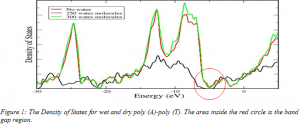Richard Marsh and Dr. James P. Lewis, Physics and Astronomy
In the world today there is an immense interest in the field of nanotechnology. One particularly unique aspect is molecular electronics. The ability to take one molecule and use it as a transistor has vast applications. While the transistors on our current computers are on the order of micrometer, a molecular wire has the capability of taking transistors into the nanometer region. Such a development would drastically increase computer speed and make the next generation of computers more compact and more manageable. One possible nano-wire is DNA. DNA has several electronic properties that could possibly render it into an excellent wire. Our goal is to better understand these properties and see if the idea of DNA as a molecular wire has merit.
In our studies we used two strands of DNA, poly (A)-poly (T) and poly (G)-poly(C). The first is composed of 10 base pairs of Adenine and Thymine while the second strand had 10 Guanine-Cytosine base pairs. Even though our strands only contain 10 base pairs, the system consists of hundreds of atoms. To calculate the electronic structure of these complex molecules in a complicated setup would require greater amounts of computing power, time, and resources than currently we have available.
To model the DNA strands we used a program called “FIREBALL”, which began as an improvement on the Sankey-Niklewski method. It is distributed and developed by the Lewis Group here at Brigham Young University. With the continuing increase in computational power and through better theoretical techniques, FIREBALL now allows us to perform very accurate calculations in more complex systems. The need for this method arises because when applying certain theoretical considerations to DNA charge-transfer experiments, one must also take into account the dynamics of the DNA structure. Specifically, the locations of the atoms in the DNA vary with time due to the twists, turns, bends, and other motions of the DNA molecule. What makes FIREBALL so impressive is that it makes our almost impossible calculations solvable relatively quickly and easily. FIREBALL does this by making a couple of assumptions. The first assumption is that the core electrons do not contribute to the electronic properties. The second assumption is that we cut off the wave functions at some distance. So instead of wave functions that go to infinity, we have them equal to zero at some specific radius. While sacrificing a small amount of accuracy with these approximations, FIREBALL allows us to analyze our system quickly and efficiently.
In our experiments we ran a simulation of our DNA strands at room temperature for 1.5 nanoseconds. During the simulation we took 100 ‘snapshots’ of the molecules. Initially we did not include an environment while adding hydrogen to the phosphate backbone to neutralize the charge. We then took one of the snapshots from the A-T structure and also one for the G-C structure and analyzed them using the FIREBALL method. From this we calculated the Density of States, which tells us the electronic band structure. Our results show that there is a small gap in the band structure. Our preliminary conclusion was that the molecules were semiconducting. The next step was to identify the location of the HOMO state. Using FIREBALL, we found the state to be at the beginning of the band gap region. With these results we concluded that the DNA molecule is semiconducting.
Knowing the location of the HOMO and LUMO states also enables us to determine where the charge transfer will take place. Using FIREBALL we identified the location of both the HOMO and LUMO states. The interesting part is that both of these states lie on a base pair. As the molecule moves in time, the HOMO and LUMO states remain on one of the base molecules. This is interesting because mobile HOMO and LUMO states can actually facilitate charge transfer, improving the conducting ability of the DNA molecule.
The next step in our experiment is to see how the environment of the DNA affects its electronic properties. One common solvent for the molecule is water. So we took our strands of DNA and immersed them in water. We repeated our previous procedure to investigate the electronic structure of wet DNA. From FIREBALL we obtained the Density of States for both wet poly (A)-poly (T) and wet poly (G)-poly(C). The Density of States for the poly (A)-poly (T) molecule in various solvation layers is shown in figure 1 below. We noted that there are some electronic states in the band gap region. So we investigated the origin of these states for both types of DNA molecules. We found that in both cases the states in the band gap region are due to the water molecules surrounding the DNA. We believe this to be because the water is not in its optimized location. The water is randomly placed around the DNA in our initial calculations and not in the location where they will be in real life. But the more important part is that the electronic structure of the DNA around the band gap region is unchanged. This means that wet DNA is semiconducting. However, further analysis is needed to confirm our findings.
In summary, we have used FIREBALL to calculate the electronic Density of States for poly (A)-poly (T) and poly (G)-poly(C). The electronic band structure indicates that these molecules are semiconducting. We repeated our experiment placing the DNA in an aqueous solution of varying salvation layers and found the wet DNA to be semiconducting. Nevertheless, more data is needed to confirm our conclusions.

